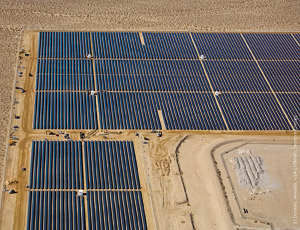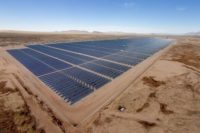A 290-MW photovoltaic powerplant is on track for construction to start later this summer in Arizona, marking the beginning of a wave of utility-scale solar projects expected to wash over the Southwest.

The push to build solar plants like the Agua Caliente project near Yuma is driven by two key factors: state renewable-energy requirements and a drop in solar prices, especially for photovoltaic technology.
Nine western states have renewable portfolio standards requiring utility electric sales to include 5% to 33% renewable resources by 2015 to 2025, respectively, depending on the state. To meet those requirements, the west will need to add roughly 42,000 MW of renewable capacity, according to Overland Park, Kan.-based Black & Veatch.
While demand for renewable resources is rising in the west, photovoltaic costs are falling, partly because manufacturers are ramping up their production lines. First Solar, a thin-film photovoltaic manufacturer and project developer based in Tempe, Arizona, estimates that, by 2014, it will sell power from its projects for $100 per MW-hour to $120 per MW-hour, which would make its solar facilities competitive with combined-cycle natural-gas- fired powerplants, according to Alan Bernheimer, First Solar spokesman.
First Solar’s existing power purchase agreements have prices ranging from $140/MWh to $160/MWh, he says.
The move to price parity with natural- gas plants is driven by cutting costs. First Solar expects to trim the cost of its solar modules by about 38% by 2014—to around $580,000/MW—mainly through improved manufacturing efficiency. Lowered installation costs will help cut the “balance of system” expenses, which cover all costs except the solar modules, by about 32% by 2014 to about $950,000/MW, the company estimates.
First Solar expects to become the owner of Agua Caliente later this year by buying the project’s developer, NextLight Renewable Power. In late April, First Solar agreed to buy NextLight, a utility-scale photovoltaic developer based in San Francisco, for about $285 million. Earlier this month, the California Public Utilities Commission approved a 25-year power purchase agreement between the Agua Caliente project and Pacific Gas & Electric, a San Francisco-based utility. First Solar’s purchase of NextLight depended on PUC’s approval of the power purchase agreement. First Solar and NextLight have power purchase agreements with utilities totaling 2,200 MW.
First Solar will use its own solar modules for the Agua Caliente facility and act as its own contractor for the project, Bernheimer says. The company expects to begin delivering power from the plant to PG&E in 2012 and complete the project by December 2014.


Post a comment to this article
Report Abusive Comment